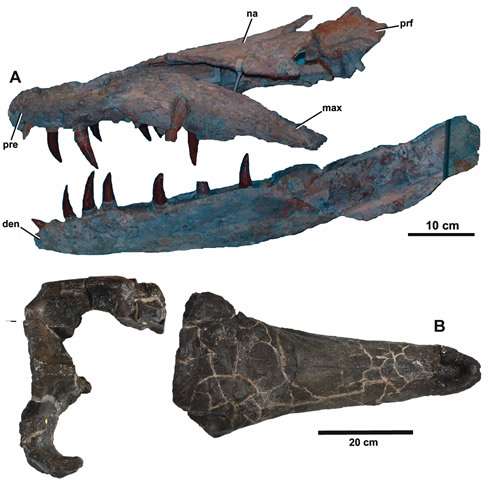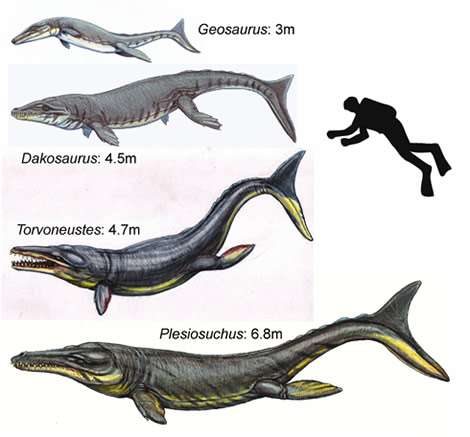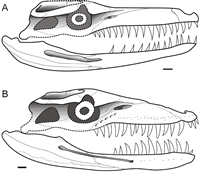Fossil skulls of crocodylians Dakosaurus maximus (A) and Plesiosuchus manselii (B). Credit: Young et al, Phil Hurst NHM
(Phys.org)—Crocodiles are often thought of as living fossils, remaining unchanged since the time of the dinosaurs. But scientists have shown this is not always the case and that 150 million years ago, their feeding mechanisms were more similar to some mammals living today, the killer whales.
An international team led by Dr Mark Young of the University of Edinburgh, and including Dr Lorna Steel at the Natural History Museum, studied two species of extinct marine dolphin-like crocodylians, Dakosaurus maximus and Plesiosuchus manselii. Their research is published today in the journal PLoS One.
Dakosaurus and Plesiosuchus were among the top predators living in the shallow seas that covered England around 150 million years ago. Their fossils were uncovered from Dorset and Cambridgeshire in England, and Germany.
The team reconstructed the skull and teeth of the two species and then compared them with living marine mammals and reptiles.
Although Dakosaurus and Plesiosuchus had skulls more similar to the dinosaur T.rex, the results showed that their feeding patterns were more like mammals. In fact, they showed striking similarity to North Atlantic killer whales.
Young explains, 'There are two "types" of North Atlantic killer whales: the first is large-bodied (more than 2m longer than the smaller type) and the teeth have no tooth wear, while the second is smaller-bodied and the teeth show extensive tooth wear. This is the same pattern we see in these fossil crocodiles.
'The fact that two unrelated groups, separated by around 152 million years evolved a similar set of morphofunctional adaptations in western Europe came as quite a surprise.'
These four closely related crocodylians lived in western Europe about 152 million years ago. They all had different body lengths and feeding mechanics. Credit: Young et al., Dmitry Bogdanov
First suction feeder
They also found that Dakosaurus had skull and jaw characteristics like living suction-feeding dolphins (killer whales belong to the oceanic dolphin family), which would make Dakosaurus the first known suction-feeding crocodylian.
Not living fossils
Dakosaurus and Plesiosuchus were part of a diverse group of marine crocodylians in the family Metriorhynchids. They varied hugely in body size, lifestyle and feeding strategy.
'This research shows that crocodiles are not "living fossils",' says Young. 'The long fossil record of crocodiles show they did many of the things living mammals do today.'
'There were some terrestrial crocodiles with mammal-like teeth and also crocodiles that left the land and became fully marine,' says Young. 'They evolved some remarkable adaptations for marine life, from flippers to a shark-like tail fin.'
Reconstruction of the skulls of Plesiosuchus manselii (A) and Dakosaurus maximus (B). Credit: Young et al.
Lots of top predators
Another question that has intrigued scientists is how such a large variety of top predators could live together side by side in the same ecosystem without competing with each other.
This new research helps answer this problem. 'The skull and tooth morphology show that they all ate different prey, and fed in different ways,' says Steel.
'We think that Plesiosuchus specialised in eating other marine reptiles, and Dakosaurus was a generalist, probably eating fish and whatever else it could get hold of, perhaps including the small metriorhynchid Geosaurus,' adds Steel. In ecology, this is known as niche partitioning.
Move to a new genus
The team's results also reclassified Plesiosuchus manselii. Previously it was in the same genus as Dakosaurus maximus but now is in its own genus Plesiosuchus.
Next steps
The team would like to delve deeper into understanding the feeding mechanics of these and other marine predators. Steel concludes, 'Our next step is to make an engineering analysis of the skulls of modern killer whales and the Jurassic metriorhynchids.'
Journal information: PLoS ONE
Provided by Natural History Museum
























